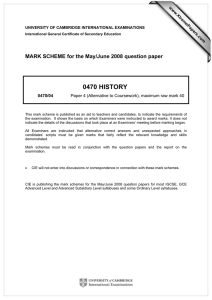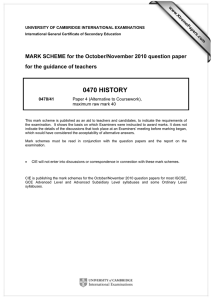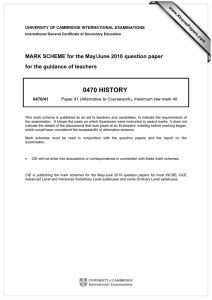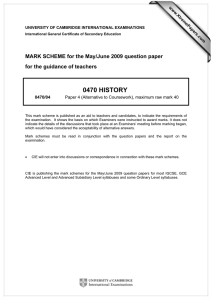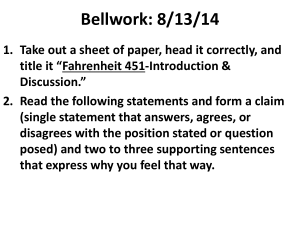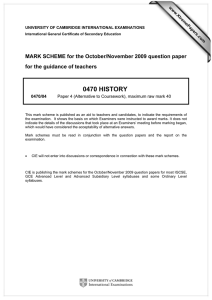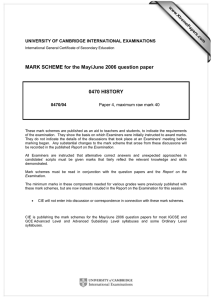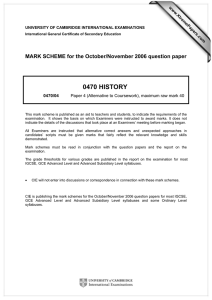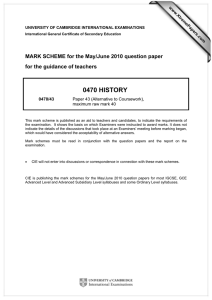0470 HISTORY MARK SCHEME for the October/November 2008 question paper
advertisement
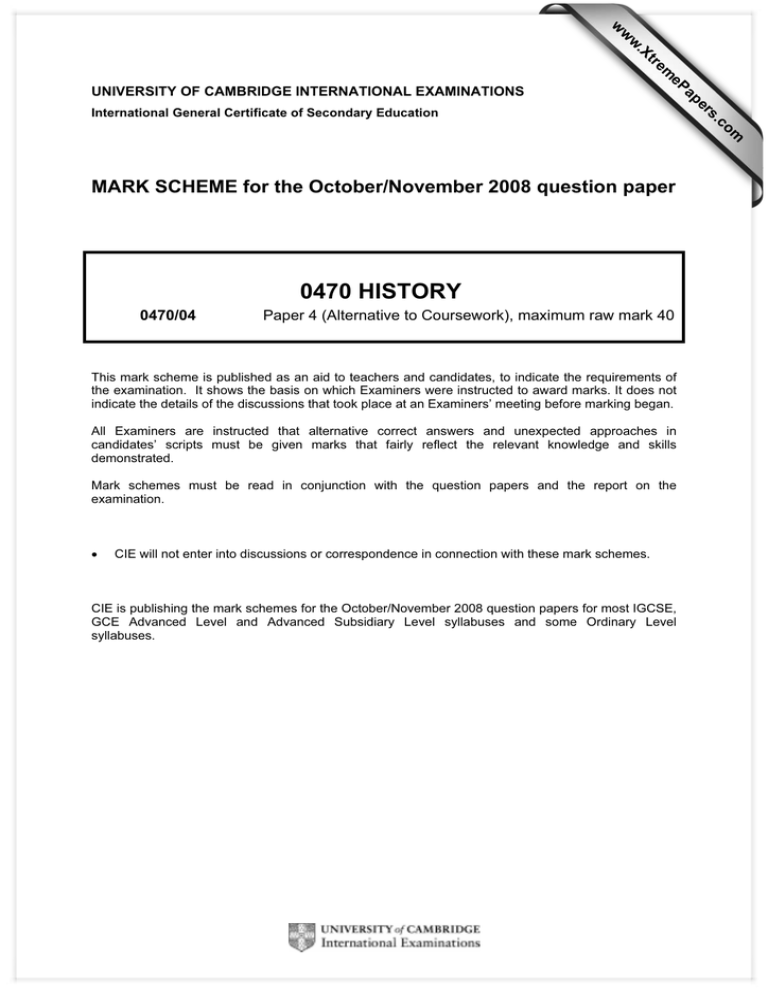
w w ap eP m e tr .X w UNIVERSITY OF CAMBRIDGE INTERNATIONAL EXAMINATIONS 0470 HISTORY 0470/04 Paper 4 (Alternative to Coursework), maximum raw mark 40 This mark scheme is published as an aid to teachers and candidates, to indicate the requirements of the examination. It shows the basis on which Examiners were instructed to award marks. It does not indicate the details of the discussions that took place at an Examiners’ meeting before marking began. All Examiners are instructed that alternative correct answers and unexpected approaches in candidates’ scripts must be given marks that fairly reflect the relevant knowledge and skills demonstrated. Mark schemes must be read in conjunction with the question papers and the report on the examination. • CIE will not enter into discussions or correspondence in connection with these mark schemes. CIE is publishing the mark schemes for the October/November 2008 question papers for most IGCSE, GCE Advanced Level and Advanced Subsidiary Level syllabuses and some Ordinary Level syllabuses. om .c MARK SCHEME for the October/November 2008 question paper s er International General Certificate of Secondary Education Page 2 Mark Scheme IGCSE – October/November 2008 Syllabus 0470 Paper 04 Depth Study A: Germany, 1918-1945. 1 (a) (i) Level 1 [1–2] Level 2 Makes valid inferences, unsupported from the source e.g. Money was worthless, people bartered etc. [3–4] Level 3 Supports valid inference(s) with reference to the source e.g. Lawyers paid in food, cinema tickets paid for with coal showed money was worthless and people bartered etc. [5–6] (ii) Level 1 (b) Repeats material stated in source, no inference made. Agrees OR disagrees, no support from source. [1–2] Level 2 Agrees OR disagrees, supported from source e.g. Yes, Germans unable to afford goods and meals in restaurants, emotionally crippled with envy. No, Swiss able to get marvellous value by shopping in Germany etc. [3–5] Level 3 Agrees AND disagrees, supported from the source. Addresses the issue of ‘How far?’ [6–7] (iii) Level 1 Useful/not useful – Choice made on the basis that one is more detailed/gives more information, but does not specify what information. [1] Level 2 Useful/not useful – One is by a journalist and one is by an historian so they could both be biased/unreliable. [2] Level 3 Choice made on the nature or amount of information given. Must specify what information. [3–5] Level 4 Choice made on the grounds of reliability. Discussion of utility must be made on valid evaluation of source(s) in context. Include at this Level answers that cross-reference between A and B to show reliability. 6 marks for one source, 7 marks for both. [6–7] (i) One mark for each valid aspect to a maximum of two e.g. Payments ordered by the Treaty of Versailles to be made by Germany to compensate some of the victors for damage caused etc. [1–2] (ii) Level 1 Level 2 (iii) Level 1 Level 2 Identifies the occupation. [1–2] Develops the occupation. Award an extra mark for each aspect described in additional detail e.g. French reaction to non-payment of reparations. German passive resistance. French violence towards Germans. Printing of money to compensate strikers led to hyperinflation. [2–4] Single reason. One for the reason, one for the explanation. [1–2] Multiple reasons. One for each reason, one for each reason explained e.g. A protest about the Weimar government’s handling of the occupation of the Ruhr area. Failed because the Bavarian troops/police would not support the putsch, dispersed easily by loyal troops, insufficient numbers to achieve success etc. NB Only one aspect attempted – Maximum of 4 marks. [2–6] © UCLES 2008 Page 3 Mark Scheme IGCSE – October/November 2008 Syllabus 0470 (iv) Level 1 Simple assertions. Yes, they were great times. Paper 04 [1] Level 2 Explanation of stability OR lack of stability, single factor given e.g. Yes Had dealt with the early crises of putsches and hyperinflation. Stresemann and Golden Years, loans from America – Dawes and Young. Rentenmark and called off Ruhr strike. 1924 Locarno Treaty and 1926 joins the League of Nations. Germany now respectable and Berlin the place to be. No Success based on foreign loans. Stresemann’s death. Conservative Germans and minority parties thought that Germany was humiliated by paying reparations and dealing with the enemy; also disliked the morals of Berlin. German farmers unhappy. [2] Level 3 Explanation of stability OR lack of stability, with multiple factors given. All single factors with multiple reasons. OR Undeveloped assertions on both sides of the argument (annotate BBB – Balanced but Brief). [3–5] Level 4 Answers that offer a balanced argument. BOTH sides of stability AND lack of stability must be addressed. [6–8] Depth Study B: Russia, 1905-1941. 2 (a) (i) Level 1 Repeats material stated in source, no inference made. [1–2] Level 2 Makes valid inferences, unsupported from source e.g. Stalin would have to be ruthless to make changes etc. [3–4] Level 3 Makes valid inference(s), with reference to the source e.g. History would forgive Stalin’s ruthlessness if he was successful etc. [5–6] (ii) Level 1 Agrees OR disagrees, unsupported from source. [1–2] Level 2 Agrees OR disagrees, supported from source e.g. Yes, statistics for 1934 and 1937 point to success. No, opposition and Stalin’s blame of his officials, some farms decollectivised show a stuttering movement etc. [3–5] Level 3 Agrees AND disagrees, supported from source. Addresses the issue of ‘How far?’ [6–7] (iii) Level 1 Useful/not useful – Choice made on the basis that one is more detailed/gives more information, but does not specify what information. [1] Level 2 Useful/not useful – One is from a Russian, the other is from a British book so they could both be biased/unreliable. [2] Level 3 Choice made on the nature or amount of information given. Must specify what information. [3–5] © UCLES 2008 Page 4 Mark Scheme IGCSE – October/November 2008 Syllabus 0470 Paper 04 Level 4 Choice made on the grounds of reliability. Discussion of utility must be made on valid evaluation of source(s) in context. Include at this Level answers that cross-reference between A and B to show reliability. 6 marks for one source, 7 marks for both. [6–7] (b) (i) One mark for each valid aspect to a maximum of two e.g. A class of richer peasants that emerged from Stolypin’s land reforms. Disliked by poorer peasants and targeted by Stalin. [1–2] (ii) Level 1 Identifies elements. e.g. Replace War Communism, re-introduce incentives. [1–2] Level 2 Develops elements. Award an extra mark for each element described in additional detail e.g. Only large-scale industry remained in state hands (coal, iron, steel, transport, banking, power). Small scale industries in private hands. Strong profit motives. Peasants allowed to sell surplus after tax etc. [2–4] (iii) Level 1 Single reason. One for the reason, one for explanation. [1–2] Level 2 Multiple reasons. One for each reason, one for each reason explained e.g. As a reaction to ‘non-communist’ NEP; small scale farming was inefficient; large farms could use tractors etc. To sell surplus grain to buy foreign technology. To rid himself of the Kulak class. [2–6] (iv) Level 1 Simple assertions No, there was little by way of progress. [1] Level 2 Explanation of improvement OR lack of improvement, single factor given: Yes Completion of collectivisation, increased crops, industry challenging USA, more jobs, more food, housing, healthcare education, mechanisation. No Famine at times, no personal freedom, long hours, purges, culture to support Party, most lived a limited and downtrodden life etc. [2] Level 3 Explanation of benefit OR lack of benefit, multiple factors given. Allow single factors with multiple reasons. OR Undeveloped suggestions on BOTH sides of the argument (annotate BBB – Balanced but Brief). [3–5] Level 4 Answers that offer a balanced argument. BOTH sides of benefit AND lack of benefit must be addressed. © UCLES 2008 [6–8] Page 5 Mark Scheme IGCSE – October/November 2008 Syllabus 0470 Paper 04 Depth Study C: The USA, 1919-1941. 3 (a) (i) Level 1 Repeats material stated in source, no inference made. [1–2] Level 2 Makes valid inference, not supported from source e.g. It was in a mess, serious trouble, needed help etc. [3–4] Level 3 Supports valid inference(s) with reference to the source e.g. Big job, dilapidated and messy buildings need a new coat of paint. Roosevelt’s plan welcomed by look on animals’ faces but will it be too big a job? [5–6] (ii) Level 1 Agrees OR disagrees with no support from source. [1–2] Level 2 Agrees OR disagrees with source, supported from source e.g. Yes, had dealt with bank crisis; increased confidence, income, demand; government accepts role in relief. No, new problems of 1938; still unemployment; dangers and distress only reduced, not resolved etc. [3–5] Level 3 Agrees AND disagrees, supported from source. Addresses the issue of ‘How far?’ [6–7] (iii) Level 1 Useful/not useful – Choice made on the basis that one is more detailed/gives more information, but does not specify what information. [1] Level 2 Useful/not useful – One is a cartoon and the other is from Roosevelt so they could both be biased/unreliable. [2] Level 3 Choice made on the nature or amount of information given. Must specify what information. [3–5] Level 4 Choice made on the grounds of reliability. Discussion of utility must be made on valid evaluation of source(s) in context. Include at this Level answers that cross-reference between A and B to show reliability. 6 marks for one source, 7 marks for both. [6–7] (b) (i) One mark for each valid aspect to a maximum of two e.g. Tenant farmers; fixed proportion of crop to landowner; farmer to provide labour, implements, seed; not only Southern states – tobacco, cotton. [1–2] (ii) Level 1 Identifies aspects. [1–2] Level 2 Develops aspects. Award an extra mark for each aspect described in additional detail e.g. Dustbowl; Central and Mid-West affected; migration; led to AAA concentrating on educating farmers in better techniques etc. [2–4] (iii) Level 1 Single reason. One for the reason, one for explanation. [1–2] Level 2 Multiple reasons. One for each reason, one for each reason explained e.g. Most depressed region; poor farming; deforestation; flood damage; Federal action needed as 7 states involved; dams, electricity, jobs etc. [2–6] © UCLES 2008 Page 6 Mark Scheme IGCSE – October/November 2008 Syllabus 0470 (iv) Level 1 Simple assertions. Yes, better methods. Paper 04 [1] Level 2 Explanation of success OR other factors, single factor given e.g. Farming – AAA subsidies for lower production raised prices; farmers’ income increased; electrification and education increased efficiency; self sufficient and sent food aid to Europe during war etc. Other – Did not solve inequalities in farming; cities rather than rural areas saw most development. Candidates may choose another whole area of the New Deal to argue it was more successful than farming etc. [2] Level 3 Explanation of success OR other factors, with multiple factors given. Allow single factors with multiple reasons. OR Undeveloped suggestions on BOTH sides of the argument (annotate BBB – Balanced but Brief). [3–5] Level 4 Answers that offer a balanced argument. BOTH sides of success AND other factors must be addressed. [6–8] Depth Study D: China, 1945-c.1990. 4 (a) (i) Level 1 Repeats material stated in source, no inference made. [1–2] Level 2 Makes valid inferences, unsupported from source e.g. Every one was confident, could not lose etc. [3–4] Level 3 Makes valid inference(s) with reference to the source e.g. Confident, noisy, transport, street party and celebration shown in source etc. [5–6] (ii) Level 1 Agrees OR disagrees, unsupported from source. [1–2] Level 2 Agrees OR disagrees, supported from source e.g. Yes, signed agreements with USA, GB and Japan; foreign firms building new factories. No, the money the workers were allowed to keep fuelled the economy etc. [3–5] Level 3 Agrees AND disagrees, supported from the source. Addresses the issue of ‘How far?’ [6–7] (iii) Level 1 Useful/not useful – Choice made on the basis that one is more detailed/gives more information than the other, but does not specify what information. [1] Level 2 Useful/not useful – One source is from a reporter, the other is from a British history book so they could both be biased/unreliable. [2] Level Choice made on the nature or amount of information given. Must specify what information. [3–5] Level 4 Choice made on the grounds of reliability. Discussion of utility must be made on valid evaluation of source(s) in context. Include at this Level answers that cross-reference between A and B to show reliability. 6 marks for one source, 7 marks for both. [6–7] © UCLES 2008 Page 7 (b) Mark Scheme IGCSE – October/November 2008 Syllabus 0470 Paper 04 (i) One mark for each valid point to a maximum of two e.g. Four radical supporters of Cultural Revolution; resented by most party members because of access to Mao; toppled after Mao’s death, sentenced to death, commuted. Wife Jiang Qing, Wang Hogwen, Yao Wenyuan, Zhang Chunqiao. [1–2] (ii) Level 1 Identifies factors. [1–2] Level 2 Develops factors. Award an extra mark for each valid factor described in additional detail e.g. One of all time greats and ever present members of CCP; deprived of all posts during Cultural Revolution for ‘reactionary bourgeois tendencies’; Reinstated by friend, Zhou Enlai, to be Vice Premier of State Council in 1973 – ran government during Zhou’s illness; dismissed by Gang of Four on Zhou’s death; reinstated in 1977 after arrest of 4; confirmed as leader Dec. 1978. His special tactic was never to complain if removed or punished. [2–4] (iii) Level 1 Single reason. One for the reason, one for explanation. [1–2] Level 2 Multiple reasons. Students had supported Deng against the hardliners and demanded reform and democracy quicken; economic problems in 1988/9 undermined Deng – 30% inflation. Students demonstrated in May for democracy and an end to Party corruption. Deng did not approve but Zhao Ziyang (replaced Deng and had been PM before) announced students’ demands would be met. Also, upcoming Gorbachev visit for mid June caused students to demonstrate in the Square 3–4 June. [2–6] (iv) Level 1 Simple assertions. Yes, they could spend their own money. [1] Level 2 Explanation or relaxation OR non relaxation, single factor given e.g. Yes No More liberal approach to foreign business and economy. World Bank, IMF meant that economy grew; Chinese people bought goods, western fashion; previous reforms re women developed. Some protest allowed etc. Deng had to balance liberalisation with hardliners in the Party. So, criticism not tolerated, obedience enforced if criticism undermined the party. State still more important than the individual. Rural Chinese saw little change. [2] Level 3 Explanation of relaxation OR non relaxation with multiple factors given. Allow single factors with multiple reasons. OR Undeveloped suggestions on BOTH sides of the argument (annotate BBB – Balanced but Brief). [3–5] Level 4 Answers that offer a balanced argument. BOTH sides of relaxation AND non relaxation must be addressed. © UCLES 2008 [6–8] Page 8 Mark Scheme IGCSE – October/November 2008 Syllabus 0470 Paper 04 Depth Study E: Southern Africa in the 20th Century. 5 (a) (i) Level 1 Repeats material stated in source, no inference made. [1–2] Level 2 Makes valid inferences, not supported from source e.g. These laws have not been thought through to cope with all eventualities etc. [3–4] Level 3 Makes valid inference(s) with reference to the source e.g. Cruel, destroys families, wife dependent on husbands status, gave state great power, enforced by courts, created refugees etc. [5–6] (ii) Level 1 Agrees OR disagrees with no support from source. [1–2] Level 2 Agrees OR disagrees, supported from source e.g. Yes PAC policy; growing number of supporters; spread to Cape Town; willing to defy the law; continuous opposition. No Only one township and same speaker; only urging defiance; non-violence might indicate not enough support to take control physically etc. [3–5] Level 3 Agrees AND disagrees, supported from source. Addresses the issue of ‘How far?’ [6–7] (iii) Level 1 Useful/not useful – Choice made on the basis that one is more detailed/gives more information, but does not specify what information. [1] Level 2 Useful/not useful – One is from a South African newspaper and the other is from an American newspaper so they could both be biased/unreliable. [2] Level 3 Choice made on the nature or amount of information given. Must specify what information. [3–5] Level 4 Choice made on the grounds of reliability. Discussion of utility must be made on valid evaluation of source(s) in context. Include at this Level answers that cross-reference between A and B to show reliability. 6 marks for one source, 7 marks for both. [6–7] (b) (i) Award one mark for each valid example to a maximum of two e.g. Verwoerd; Vorster. [1–2] (ii) Level 1 Identifies events e.g. Peaceful protest march against Pass Laws. [1–2] Level 2 Develops events. Award an extra mark for each aspect described in additional detail e.g. PAC led unarmed anti-pass law demonstration of about 10 000; young policeman panicked and began shooting into the crowd; colleagues joined in – 700 rounds, 69 killed, 180 injured – mostly in the back. Worldwide shock. [2–4] (iii) Level 1 Single reason. One for the reason, one for the explanation. [1–2] Level 2 Multiple reasons. One for each reason, one for each reason explained e.g. Fear of strengthening nationalism elsewhere in Africa; resented Macmillan’s ‘Winds of Change’ speech urging an end to apartheid; referendum of 1960 had a majority for leaving the Commonwealth; acted before expelled; felt economically strong enough to stand alone. [2–6] © UCLES 2008 Page 9 Mark Scheme IGCSE – October/November 2008 Syllabus 0470 (iv) Level 1 Simple assertions. No, opposers became more militant. Paper 04 [1] Level 2 Explanation of success OR lack of success, single factor given e.g. Yes 1960 State of emergency; ANC, PAC and CP illegal; banning without trial; popular support – 1961 election increased government majority; Active citizen force; BOSS; life imprisonment for Sobukhe, Mandela, Sisulu etc. Further limits on Press; ignored world criticism. Large scale forced removals to Bantustans continued – without effective opposition. No ANC/PAC continued underground and had support from other African states, OAU; international trade boycotts; employers finding ways round laws as shortage of labour. [2] Level 3 Explanation of success OR lack of success, with multiple factors given. Allow single factors with multiple reasons. OR Undeveloped suggestions on BOTH sides of the argument (annotate BBB – Balanced but Brief). [3–5] Level 4 Answers that offer a balanced argument. BOTH sides of success AND lack of success must be addressed. [6–8] Depth Study F: Israelis and Palestinians. 6 (a) (i) Level 1 Repeats material stated in source, no inference made. [1–2] Level 2 Makes valid inference, not supported from the source e.g. It shows them to be passionate about their homeland etc. [3–4] Level 3 Makes valid inference(s), with reference to the source e.g. Passionate about the homeland, language used, calls upon God and History, but children being drilled each morning, exposed by adults to the issue etc. [5–6] (ii) Level 1 Agrees OR disagrees with no support from source. [1–2] Level 2 Agrees OR disagrees, supported from source e.g. Yes most of the piece is argued by Arafat that resistance to invaders makes them freedom fighters. No the first line admits that Arafat is conscious that other peoples see them as terrorists. [3–5] Level 3 Agrees AND disagrees, supported from source. Addresses the issue of ‘How far?’ [6–7] (iii) Level 1 Useful/not useful – Choice made on the basis that one is more detailed/gives more information, but does not specify what information. [1] Level 2 Useful/not useful – One is a Palestinian oath, the other is from Arafat so they could both be biased/unreliable. [2] © UCLES 2008 Page 10 Mark Scheme IGCSE – October/November 2008 Syllabus 0470 Paper 04 Level 3 Choice made on the nature or amount of information given. Must specify what information. [3–5] Level 4 Choice made on the grounds of reliability. Discussion of utility must be made on valid evaluation of source(s) in context. Include at this Level answers that cross-reference between A and B to show reliability. 6 marks for one source, 7 marks for both. [6–7] (b) (i) One mark for each valid example to a maximum of two e.g. PFLP, al Fatah, Hamas.[1–2] (ii) Level 1 Identifies aspects. [1–2] Level 2 Develops aspects. Award an extra mark for each aspect described in additional detail e.g. 1972 Palestinians hired Japanese gunmen, killed 28 people at Lod airport; Black September murdered Israeli athletes at Munich Olympics; may be other examples of violence quoted. Used terror and constant propaganda to keep the issue at the forefront of world consciousness. [2–4] (iii) Level 1 Single reason. One for the reason, one for the explanation. [1–2] Level 2 Multiple reasons. One for each reason, one for each reason explained e.g. To get international recognition and world opinion on his side; to give his actions some legitimacy; Camp David and involved in treaty negotiations; to demonstrate that Israeli actions broke or opposed UNO resolutions. [2–6] (iv) Level 1 Simple assertions. Yes, Arafat was elected president. [1] Level 2 Explanation of success OR lack of success, single factor given e.g. Yes 1974 recognised by Arab states as sole representative of Palestinian people. 1978 Camp David Accords. 1981/2 Israel attacked refugee camps in Lebanon to drive PLO to Tunisia. Splits occurred here. Activities of Hezbollah and Hamas (Intifadah) persuaded Israel to negotiate with more moderate PLO. Oslo Accords and Gaza-Jericho Agreement 1993. 1996 first Palestinian election 88.1% pro PLO, Arafat President. Maintained the issue to world. No Driven out of Jordan 1970/1. Driven out of Lebanon 1981/2. In Tunisia, splits and challenges to Arafat. PLO no longer the leading group – al Fatah and Hamas. No solution to the problems yet achieved [2] Level 3 Explanation of success OR lack of success, with multiple factors. Allow single factors with multiple reasons. OR Undeveloped suggestions on BOTH sides of the argument (annotate BBB – Balanced but Brief). [3–5] Level 4 Answers that offer a balanced argument. BOTH sides of success AND lack of success must be addressed. © UCLES 2008 [6–8] Page 11 Mark Scheme IGCSE – October/November 2008 Syllabus 0470 Paper 04 Depth Study G: The Creation of Modern Industrial Society. 7 (a) (i) Level 1 Repeats material stated in source, no inference made. [1–2] Level 2 Makes valid inferences, not supported from source e.g. They did not want anything exceptional; they just wanted to live comfortably in life etc. [3–4] Level 3 Makes valid inference(s) with reference to the source e.g. Wanted to have the basic things in life – ‘bread and cheese’, to work adequately and live in good health without exceptional problems etc. [5–6] (ii) Level 1 Agrees OR disagrees with no support from source. [1–2] Level 2 Agrees OR disagrees, supported from source e.g. Yes, names mean they were unpopular in some quarters; marches and organisation might threaten; claims for shorter working week, reduction of taxes and liberties might upset the ‘born to rule’ set. No, marches were peaceful, no violence or stealing, well planned peaceful meeting etc. [3–5] Level 3 Agrees AND disagrees, supported from source. Addresses the issue of ‘How far?’ [6–7] (iii) Level 1 Useful/not useful – Choice made on the basis that one is more detailed/gives more information, but does not specify what information. [1] Level 2 Useful/not useful – One is from a Chartist supporter, the other is from an actual Chartist so they could both be biased/unreliable. [2] Level 3 Choice made on the nature or amount of information given. Must specify what information. [3–5] Level 4 Choice made on the grounds of reliability. Discussion of utility must be made on valid evaluation of source(s) in context. Include at this Level answers that cross-reference between A and B to show reliability. 6 marks for one source, 7 marks for both. [6–7] (b) (i) Award a mark for each correct name to a maximum of two e.g. William Lovett; Feargus O’Connor. Right names in wrong order – one mark only. [1–2] (ii) Level 1 Identifies the 1848 presentation. [1–2] Level 2 Develops the 1848 presentation. Award an extra mark for each aspect described in additional detail e.g. Year of Revolutions. 5 500 000 signatures, Wellington in charge of defence of London; 170 000 special constables. Chartists refused permission to march from Kennington Common to Westminster. Petition delivered in rain by horse wagon. Less than 2 million signatures when counted – many frivolous. [2–4] © UCLES 2008 Page 12 Mark Scheme IGCSE – October/November 2008 Syllabus 0470 Paper 04 (iii) Level 1 Single reason. One for the reason, one for the explanation. [1–2] Level 2 Multiple reasons. One for each reason, one for each reason explained e.g. Too far reaching for its time. A working class movement, unlikely to succeed against the newly enfranchised middle class; divided leadership; Others more interested in Land League and Anti-Corn Law League; authorities well organised against them. 1848 challenged its integrity; Aims frightened people etc. [2–6] (iv) Level 1 Simple assertions. No, it folded before achieving anything. [1] Level 2 Explanation of importance OR lack of importance, single factor given e.g. Yes First really big movement with set aims. Appeared to be political for the first time. Although aims appeared to be unrealistic 5 of the 6 are now accepted and form part of our democratic process. No It failed, was humiliated in 1848, probably put back the development of other attempts to improve workers lives. Other movements learned from Chartist mistakes. Expect comparison with other workers’ movements e.g. trade unions, Co-operative movement etc. [2] Level 3 Explanation of importance OR lack of importance with multiple factors. Allow single factors with multiple reasons. OR Undeveloped suggestions on BOTH sides of the argument (annotate BBB – Balanced but Brief). [3–5] Level 4 Answers that offer a balanced argument. BOTH sides of importance AND lack of importance must be addressed. [6–8] Depth Study H: The Impact of Western Imperialism in the 19th Century. 8 (a) (i) Level 1 Repeats material stated in source, no inference made. [1–2] Level 2 Makes valid inferences, not supported from source e.g. Were shocked and dismayed at the news etc. [3–4] Level 3 Supports valid inference(s) with reference to the source e.g. Aghast at the lurid stories and details of actions against women and children; accepted the news at face value and did not detect exaggeration etc. [5–6] (ii) Level 1 Agrees OR disagrees with no support from source. [1–2] Level 2 Agrees OR disagrees with support from source e.g. Yes, both agree that the British organised their actions well and fought with bravery. B takes a very relaxed view of it all. No, C demonstrates incompetence in man management and only a few British soldiers available to fight for victory etc. [3–5] Level 3 Agrees AND disagrees, supported from source. Addresses the issue of ‘How far?’ [6–7] © UCLES 2008 Page 13 Mark Scheme IGCSE – October/November 2008 Syllabus 0470 Paper 04 (iii) Level 1 Useful/not useful – Choice made on the basis that one is more detailed/gives more information, but does not specify what information. [1] Level 2 Useful/not useful – A is a British history book, B is a British magazine and C is another British history book so they could all be biased/unreliable. [2] Level 3 Choice made on the nature or amount of information given. Must specify what information. [3–5] Level 4 Choice made on the grounds of reliability. Discussion of utility must be made on valid evaluation of source(s) in context. Include at this Level answers that cross-reference between A, B and C to show reliability. 6 marks for one source, 7 marks for more than one source. [6–7] (b) (i) One mark for each valid name to a maximum of two e.g. Bentinck, Dalhousie, Lord Ellenborough. [1–2] (ii) Level 1 Identifies events e.g. Start of the Mutiny. [1–2] Level 2 Develops events. Award an extra mark for each valid aspect described in additional detail e.g. Punishment of sepoys over cartridges led to an outbreak of violence; British caught at church, violence and atrocities increase. [2–4] (iii) Level 1 Single reason. One for the reason, one for explanation. [1–2] Level 2 Multiple reasons. One for each reason, one for each reason explained e.g. Localised. Most sepoys remained loyal. Superior British arms; severe punishments. No great response from non-military Indians. Re-inforcements. Poor communication between mutineers. Different aims so no cohesive revolt etc. [2–6] (iv) Level 1 Simple assertions. Yes, it was governed differently. [1] Level 2 Explanation of change OR lack of change, single factor given e.g. Yes It heralded the end of the East India Co. as the determining feature of rule in India and the British Raj was introduced in 1858 which laid the basis for the governance of India until the next century. Embittered relations hindered progress in some parts. Less exploitation after 1857 and more concern for inhabitants etc. No Basically an army mutiny so did not threaten British position in India. Partly exaggerated by British to show competent handling. Caused little dislocation of trade. Little impact outside a few localised areas. [2] Level 3 Explanation of change OR lack of change with multiple factors. Allow single factors with multiple reasons. OR Undeveloped suggestions on BOTH sides of the argument (annotate BBB – Balanced but Brief). [3–5] Level 4 Answers that offer a balanced argument. BOTH sides of change AND lack of change must be addressed. © UCLES 2008 [6–8]
